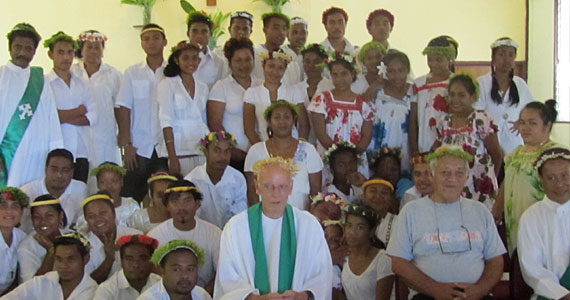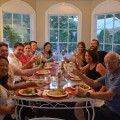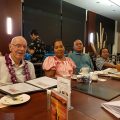Two Feast Days and Everything Between
July 31, the feast of St. Ignatius, was the first of the two. On that morning, just a few days after celebrating my cousin Ken?s 50th anniversary of priesthood on Saipan, I landed at Newark to begin a couple weeks of visiting friends and family in the US. I spent the whole day at the province infirmary, Murray-Weigel, where a growing number of my peers are to be found. Fr. Dick Hoar, who spent years in Palau, has just moved there from Buffalo this past year. Joe Billotti and Jim Gould, who both spent years in the Marshalls, are among the more active residents. We shared stories as we sipped coffee together that morning.
All day I was meeting the survivors?old teachers and mentors who are now in their 80s or 90s, men I still hold in esteem. Evening mass and dinner with those who have spent years at work in the fields of the Lord was one of the best ways to celebrate the feast of the founder of the Jesuits.
The next two weeks were a blur of visits to family and friends. A week in the Adirondacks with my brothers and their wives: a throng of about 70, proving that it?s not just islanders who enjoy extended families. A visit with Fr. Dan Mulhauser and others in Syracuse. A chance meeting in a giant store with a woman who jerked her head up when I mentioned Guam to my brother. She was a Yapese, the only one in the area, we learned. An evening with Dave Burns, a former Jesuit Volunteer who served in Chuuk during the glory days of Cecilia School, now a surgeon and father of two boys. A luncheon with a handful of old friends from high school 60 years ago, with a guided tour around downtown Buffalo by one of them.
Next on the itinerary was Minnesota, where I spent a couple of days in Milan visiting the Chuukese migrant community that now numbers about 280 people. I?ve always regarded this as a model, and I found nothing this time that would make me change my mind. Chuukese leadership is excellent, and the care offered by Minnesotans has been exemplary. When I walked into the only general store in town on Saturday night, the American owner, who was fixing the seat of a bicycle for a Chuukese boy, stopped to welcome me in Chuukese. The visit featured the usual evening basketball with young men who badly wanted to win, and also time with Tim Smit, once a Jesuit Volunteer in Pohnpei, and his wife. The only downer of that visit was that I could not say mass for the Chuukese community since I did not have up-to-date approval from the diocese.
Then there was the second feast, Assumption on August 15. By that time I was in Philadelphia for a reunion with six other Jesuits who had entered the Society 60 years ago. This visit, like the one in New York, began with a mass and dinner with the retirees?friends and other figures who are even older than me and are now living in an infirmary.
The next day the seven of us, all celebrating 60 years as Jesuits, held our party. During the dinner following our mass the stories of long ago spilled out for several hours. We might not remember requests from the day before, but we have a storehouse of memories from years ago that will never be lost. Retirement is probably not too far off for us jubilarians. But before that, we can reminisce gratefully on what we have been given even as we move forward to the work that remains to be done.






